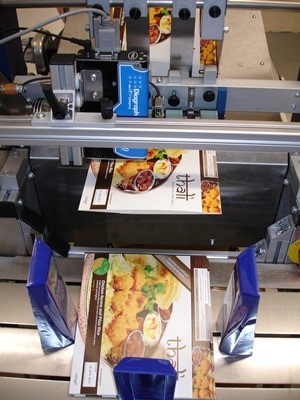 y new designs add shelf appeal, they are causing headaches for the sleeve coding operation, according to Richard Pether, Director at offline coding and marking specialist Rotech.
y new designs add shelf appeal, they are causing headaches for the sleeve coding operation, according to Richard Pether, Director at offline coding and marking specialist Rotech. “It is straightforward enough to apply best before dates and traceability codes to a sleeve wrapped around a rectangular tray that is being transported past the coder via a conveyor with good side guides. However, with more awkwardly shaped packs, the chances of presenting the pack and sleeve squarely to the coder can be slim. Getting the coder into the correct position can also be difficult, as shaped packs tend to have difficult-to-reach areas,” he explains.
“If the code misses the target area, this results in mis-coded packs, which can potentially cost ready meal manufacturers thousands in retailer fines. Even if mis-codes are spotted before a meal leaves the line, there is still a cost to the manufacturer in reworking the product. Recurrent mis-codes can lead to major production inefficiencies.”
These were the issues facing a UK prepared foods manufacturer when it contacted Rotech to enquire about an off-line sleeve overprinting system.
The manufacturer in question had just taken an order from one of the multiples for 3,000 units of a new product that was packaged in a tub with a cardboard sleeve. The manufacturer was applying date codes using an existing inline inkjet system, but because the code was positioned in a difficult-to-reach spot at the bottom of the sleeve, the line had to be slowed down to make sure the code was applied accurately.
“Essentially the coding operation had become a bottleneck because the coder was having trouble printing at an angle just a few millimetres above the conveyor; it kept mis-firing and spraying the belt rather than the product,” explains Pether. “This was not only limiting line speed, but also resulting in packaging waste.”
Rotech’s solution came in the form of its RF2, a standalone friction feed overprinting system that would enable the manufacturer to code the sleeves offline and bring them to the production line already printed. Engineered specifically for the food industry, the RF2 uses Rotech’s stack-to-stack feeding technology to pick sleeves from a stack, accurately print date or batch codes, and place the printed sleeve neatly onto another stack for collection, all at speeds of up to 400 per minute.
Pre-coding enabled the manufacturer to deactivate the inline coding system, increase line speed by 30% and code the 3,000 sleeves in a matter of minutes.
“By removing the coding operation from the critical path, line efficiency was restored and waste eliminated,” says Pether.
The beauty of an offline coding system lies in its inherent flexibility; one machine can easily supply multiple production lines. At this prepared foods manufacturer, the RF2 is also deployed for coding sleeves for seasonal trays of sausage rolls; the rest of the year the trays don’t have a sleeve, so it is only in the weeks and months leading up to Christmas that sleeve coding is required. The same system can also be used for different types of packaging, from watch strap bands to cartons, pouches and bags.
Offline coders also come into their own when immediate additional capacity or super-fast coding are needed. This scenario arose at the start of the year, when an RF2 offline sleeve coding system from Rotech got The Original Curry Company out of a tight spot.
As well as supplying the food service trade with curries and dishes in bulk, the London company produces a retail range of Indian curry based ready meals, and in March of this year, received a major export order for 2,000 frozen meals. In order to meet his retail customer’s requirements, the producer needed to apply use-by dates to the sleeves of the meals – and fast.
The Original Curry Company turned to Hertfordshire-based Rotech, who was able to supply an RF2 offline sleeve coding system at very short notice, enabling the producer to turn round the order.
“Had we hand stamped the dates, it would have held up the shipment. The RF2 was able to run off a couple of thousand sleeves in half an hour. For us, offline coding represents a higher quality, more efficient alternative to manual coding, and a more flexible, economical alternative to inline coding. We also found the off-line coder to be exceptionally accurate, giving us complete confidence that every single sleeve was clearly and correctly coded,” says James Innes from The Original Curry Company.
The RF2 can be used to print date and batch codes or simple graphics on flat cartons, sleeves, crash lock cartons, lidding materials and pouches. It is a compact stack to stack automatic system, which at high speed system can serve multiple lines offering fast change over between batches.





